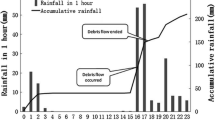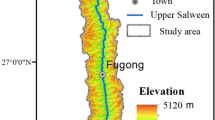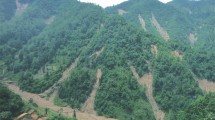Abstract
The upper reaches of Minjiang (Min) River were selected to research the relationship between debris flow fan formation and topography. Combining the historical statistical data of settlement and debris flow events, there are 3 years (1994, 2004, and 2014) for which comparable data are available. With the support of remote sensing (RS) and geographic information system (GIS) technology, the distribution characteristics and evolution of valley settlements and debris flow fans in terrain conditions with varying elevation, slope, and slope aspect are analyzed. The coupled relationship between valley settlement and debris flow accumulation fan evolution is analyzed by regression analysis. The results show that the distribution characteristics of valley settlements and debris flow fans in the upper reaches of Min River show high consistency and convergence in different topographic conditions, and they have a response relationship with each other. With elevation, both settlements and debris flow fans increase linearly with each other, and, over time, the rate of change of the distribution of valley fans with debris flow accumulation increases then decreases. In regard to slope, both parameters conform to two polynomial function models, that is, the river valley settlement increases first and then decreases with the increase of debris flow accumulation fans. For the slope aspect, the number of valley settlements increases with the increase of the change rate of debris flow fans density. The study will provide some assistance for the countermeasures on valley settlements to the evolution of debris flow fans in the upper reaches of Min River.






Similar content being viewed by others
References
Campbell RH (1975) Soil slip, debris flow, and rainstorms in the Santa Monica Mountains and vicinity, southern California. Geol Surv Prof Pap 851:1–51
Chen GJ, Fang YP, Chen Y, Shen MY, Yang DG, Wang Q, Liu SQ, Gao YJ (2007) Mountain development report: Chinese mountain settlement research. The Commercial Press, Beijing
Deng W, Cheng GW, Wen AB (2008) The conception of mountain science development in China. Bull Chin Acad Sci 23(2):156–161
Diao CT (1999) Urban geomorphology. Southwest China Normal University Press, Chongqing
Ding MT, Miao C (2015) Comparative analysis of the distribution characteristics of geological hazards in the Lushan and Wenchuan earthquake-prone areas. Environ Earth Sci 74(6):5359–5371
Ding MT, Heiser M, Hübl J, Fuchs S (2016) Regional vulnerability assessment for debris flows in China—a CWS approach. Landslides 13(3):537–550
Fleischmann CM (1986) (USSR), Translated by Yao DJ) Debris flow. Science Press, Beijing
Fu WX, Nie DX, Ren GM, Chen HJ, Wan ZL, Yang TJ, Zhang FR (1997) The study on debris flow’s distribution regularity in China. Chin J Geol Hazards Control 8(4):39–43
Geospatial Data Cloud (n.d.) http://www.giscloud.cn/ 24 October 2015
Institute of Remote Sensing and Digital Earth Chinese Academy-Open Spatial Data Sharing Project RADI. http://ids.ceode.ac.cn/ (n.d.) 9 August 2015
Kang ZC, Li ZF, Ma AN, Luo JT (2004) Study on debris flow in China. Science Press, Beijing
Larsen MC, Torres-Sánchez AJ (1998) The frequency and distribution of recent landslides in three montane tropical regions of Puerto Rico. Geomorphology 24(4):309–331
Li ZY, Yang YY (1994) Introduction to engineering geology. China University of Geosciences Press, Wuhan
Liu MC (2010) A study on the relationship between landform and development of settlements in Yunlin, Chiayi and Tainan. Chinese Culture University, Master Thesis, Taipei
Liu YG, Liao YS, Huang CM, Wang Q (2017) Spatial distribution of the mountain settlement niche and its relationship with terrain factors—a case study of Min River. J Nat Sci Hunan Normal Univ 40(1):17–25
Mao G, Hu YP, Cen Y (2014) The safety of the settlement in mountain area with frequent geological disasters—examples of villages and towns in the Hengduan Mountains. J Xi'an Univ Architect Technol (Nat Sci Ed) 46(1):101–108
Miao C, Ding MT (2017) Analysis of influence of natural disaster on the economy and prediction of recovery time based on grey forecasting–difference comparison model: a case study in the upper Min River. Nat Hazards 85(2):1135–1150
Nan X, Yan D, Li AN, Lei GB, Cao XM (2015) Mountain hazards risk zoning in the upper reaches of Minjiang River. J Catastrophol 4(30):113–120
Roy SS, Jana NC (2015) Impact of geomorphic attributes on rural settlement distribution: a case study of Baghmundi Block in Purulia District, West Bengal. Int J Innov Res Dev 4(8):121–132
Shen MY (2006) Research on theory and practice of mountain settlement development. Bashu Publishing House, Chengdu
Shinde NN, Gajhans DS (2015) Distribution pattern of rural settlement of Jalgoan District. Indian Streams Res J 4(12):1–4
Song WX, Di BF, Zuo J, Luo WF, Zhang M (2014) The adaptation analysis for settlement responded to mountain disasters—a case study of Yinchanggou in Pengzhou. Mountain Res 32(2):212–218
Tang BX, Wu JS (1990) Mountain natural hazards dominated (mainly debris flow) and their prevention. Acta Geograph Sin 45(2):202–209
General Administration of Quality Supervision, Inspection and Quarantine of the People's Republic of China. Comprehensive control of soil and water conservation—General rules of planning(GB/T15772-2008). Issued 14 November 2008
VanDine DF (1985) Debris flows and debris torrents in the southern Canadian Cordillera. Can Geotech J 22(1):44–68
Wang GX, Deng W, Yang Y, Cheng GW (2011) The advances, priority and developing trend of alpine ecology. J Mt Sci 29(2):129–140
Yu B, Li L, Ma Y, Zhang JN, Wu YF, Zhang HH, Chu SM, Qi X (2011) Research on topographical factors in the formation of gully type debris flows. River, Coastal and Estuarine Morphodynamics. Tsinghua University Press, Beijing
Zhang PL (2017) A study of the human–environment relationship in Lanzhou Basin based on topography. Lanzhou University, Master Thesis, Lanzhou
Zhong XH, Liu SZ (2014) Research on the mountain classification in China. Mountain Res 32(2):129–140
Zhu B, Zhang XL, Ma XD (2014a) The spatial pattern of rural settlements and influencing factors in Northern Jiangsu area. Res Agric Modern 35(4):453–459
Zhu Y, Yu B, Qi X, Wang T, Chen YJ (2014b) Topographical factors in the formation of gully type debris flows in the upper reaches of Minjiang River. J Jilin Univ (Earth Sci Ed) 44(1):268–277
Funding
The study was financially supported by the National key research and development program (Grant No. 2018YFC1505402), National Natural Science Foundation of China (Grant No. 41871174), Opening fund of State Key Laboratory of Geohazard Prevention and Geoenvironment Protection (Chengdu University of Technology) (Grant No. SKLGP2019K018), and the Fundamental Research Funds for the Central Universities (Grant No. 2682019CX19).
Author information
Authors and Affiliations
Corresponding authors
Rights and permissions
About this article
Cite this article
Ding, M., Tang, C. & Miao, C. Response analysis of valley settlements to the evolution of debris flow fans under different topographic conditions: a case study of the upper reaches of Min River, China. Bull Eng Geol Environ 79, 1639–1650 (2020). https://doi.org/10.1007/s10064-019-01641-9
Received:
Accepted:
Published:
Issue Date:
DOI: https://doi.org/10.1007/s10064-019-01641-9




